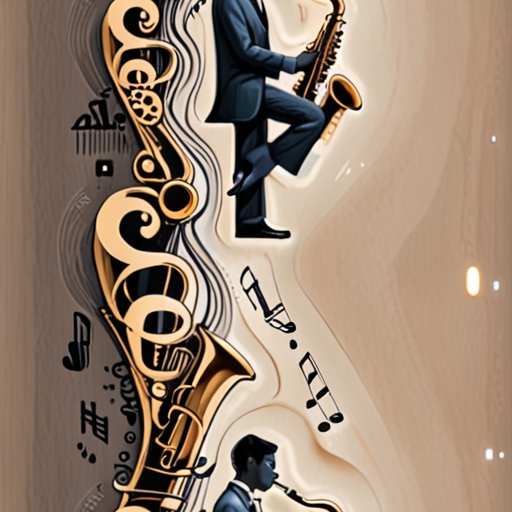The evolution of jazz fusion music charts has been a fascinating journey, marked by innovative experimentation and creative expression. As we delve into the world of jazz fusion, it becomes clear that two legendary artists, Miles Davis and Herbie Hancock, played pivotal roles in shaping its sound and style. Their contributions not only pushed the boundaries of traditional jazz but also paved the way for future generations of musicians to explore new sounds and genres. From the iconic albums of the 1970s to the contemporary scene, jazz fusion continues to captivate audiences worldwide, inspiring a new wave of artists to blend styles and push the limits of musical creativity.

Artist Known for Fusion Jazz
As a fan of jazz fusion, I’m excited to share my knowledge with you.
- Herbie Hancock is often credited as one of the pioneers of jazz fusion, blending elements of jazz, rock, and funk to create a unique sound.
- Miles Davis was another influential figure in the genre, experimenting with electronic instruments and incorporating rock and funk influences into his music.
- Tony Williams, a drummer and composer, played a crucial role in shaping the sound of jazz fusion, particularly during his work with Miles Davis.
- The Mahavishnu Orchestra, led by John McLaughlin, was a prominent band in the jazz fusion scene, known for their complex compositions and virtuosic musicianship.
- Jane Bunnett, a Canadian saxophonist, has made significant contributions to the genre, incorporating elements of Latin music and world rhythms into her work.
Fusion jazz continues to evolve, with contemporary artists pushing the boundaries of the genre.
Notable Artists and Bands
- Return to Forever, a band founded by Chick Corea, is renowned for their intricate arrangements and virtuosic performances.
- The Pat Metheny Group, led by guitarist Pat Metheny, has been a major force in the jazz fusion scene, exploring a wide range of musical styles and themes.
- Weather Report, a band co-founded by Joe Zawinul, was a key player in the development of jazz fusion, incorporating elements of rock, funk, and world music into their sound.
- George Duke, a keyboardist and vocalist, was a highly influential figure in the genre, known for his eclectic blend of jazz, rock, and R&B.
- Al Di Meola, a guitarist and composer, has released numerous albums that showcase his mastery of jazz fusion, incorporating elements of classical music and world rhythms into his work.
Exploring the Genre
If you’re interested in learning more about jazz fusion, I recommend checking out some of the classic albums and artists mentioned above.
You can also explore newer releases and emerging artists in the genre, which continue to push the boundaries of what’s possible in jazz fusion.
Remember to always support your favorite artists and bands by purchasing their music and attending live performances whenever possible.
The Godfather of Jazz Fusion
Larry Coryell is often referred to as the Godfather of Fusion due to his significant contributions to the genre.
- Coryell’s work spanned over five decades, during which he collaborated with numerous prominent musicians, including Miles Davis, Chet Baker, Charles Mingus, and John McLaughlin.
- His unique blend of jazz and rock influences helped shape the sound of fusion music, paving the way for future generations of artists.
- Coryell’s influence can still be heard in contemporary music, with many modern artists drawing inspiration from his innovative style.
Tiger Funk celebrates the rich history and cultural significance of funk, soul, and jazz fusion music through in-depth articles, artist profiles, album reviews, and historical retrospectives.
Other notable figures who have made significant contributions to the development of jazz fusion include:
- Miles Davis, whose experimental approach to jazz helped lay the groundwork for fusion.
- Herbie Hancock, who incorporated electronic elements into his music, further expanding the boundaries of jazz fusion.
- Return to Forever, a band led by Chick Corea, which pushed the limits of jazz fusion with their complex compositions and virtuosic performances.
These pioneers, along with Larry Coryell, have played a crucial role in shaping the sound of jazz fusion and continue to inspire new generations of musicians and fans alike.

Why Was Jazz Fusion Controversial?
Jazz fusion was a genre that emerged in the late 1960s and early 1970s, characterized by its blend of jazz, rock, and electronic music elements.
- The controversy surrounding jazz fusion stemmed from its departure from traditional jazz forms and its adoption of elements from other genres, such as rock and electronic music.
- Jazz purists saw jazz fusion as a watered-down version of true jazz, lacking the complexity and sophistication of earlier jazz styles.
- Others criticized jazz fusion for its emphasis on technical virtuosity and showmanship, which they felt detracted from the emotional intensity and spontaneity of traditional jazz.
Despite these criticisms, jazz fusion continued to evolve and gain popularity throughout the 1970s and beyond, influencing a wide range of musical genres and artists.
Key Factors Contributing to the Controversy
- Lack of Traditional Jazz Roots: Many critics felt that jazz fusion lacked the deep roots in traditional jazz that had defined earlier styles.
- Emphasis on Technical Virtuosity: The increasing emphasis on technical skill and showmanship in jazz fusion led some to see it as more concerned with display than with genuine artistic expression.
- Blending of Genres: The blending of jazz with elements from other genres, such as rock and electronic music, was seen by some as a dilution of the jazz tradition.
Influence of Key Artists and Bands
- Miles Davis’s Bitches Brew (1969) is often cited as a landmark album in the development of jazz fusion.
- The Mahavishnu Orchestra’s The Inner Mounting Flame (1971) pushed the boundaries of jazz fusion with its complex time signatures and extended instrumental passages.
- The Weather Report’s I Sing the Body Electric (1972) showcased the band’s unique blend of jazz, rock, and electronic music elements.
Legacy of Jazz Fusion
Jazz fusion has had a lasting impact on the development of popular music, influencing a wide range of genres from smooth jazz to electronic dance music.
Many contemporary musicians continue to draw upon the innovations and experimentation of jazz fusion, pushing the boundaries of what is possible in popular music.
Tiger Funk celebrates the rich history and cultural significance of funk, soul, and jazz fusion music through in-depth articles, artist profiles, and album reviews.
For more information on jazz fusion and its legacy, visit our website at https://tigerfunk.com/ .

Who Dominated Jazz Fusion?
Miles Davis, the legendary trumpeter, was at the forefront of fusing jazz, rock, and funk.
- His pioneering albums In A Silent Way and Bitches Brew featured electric instruments and rock rhythms anchored by jazz improvisation
- Davis’ fusion experiments laid the groundwork for countless others, including Herbie Hancock, who released his groundbreaking album Head Hunters in 1973
- Hancock’s album showcased his mastery of jazz-funk and its potential for commercial success, paving the way for future generations of musicians
- Other notable figures in the jazz fusion scene include Weather Report, led by Joe Zawinul and Wayne Shorter, and Return to Forever, featuring Chick Corea and Al Di Meola
- These artists pushed the boundaries of what was possible in jazz, incorporating elements of rock, funk, and electronic music into their work
- Jazz fusion’s influence can still be heard today, with many contemporary musicians drawing inspiration from its innovative spirit and sonic experimentation
Tiger Funk celebrates the rich history and cultural significance of funk, soul, and jazz fusion music through in-depth articles, artist profiles, and album reviews
Our mission is to educate and inspire readers about these influential genres and their impact on modern music
We strive to provide a comprehensive resource for fans and enthusiasts, highlighting the evolution of funk, soul, and jazz fusion and their continued relevance in today’s musical landscape
For more information on jazz fusion and its legacy, visit our website at https://tigerfunk.com/
Discover the fascinating stories behind the genre’s most iconic albums and artists, and explore the ways in which jazz fusion continues to shape the sound of contemporary music
At Tiger Funk, we’re passionate about sharing the beauty and complexity of jazz fusion with a wider audience, and we invite you to join us on this journey of discovery and exploration
The Father of Jazz Fusion
Miles Davis is often regarded as the father of jazz fusion due to his pioneering work in blending jazz with rock and electronic elements.
- His iconic albums “In a Silent Way” (1969) and “Bitches Brew” (1970) revolutionized the genre by combining the improvisational nature of jazz with the electric instruments and psychedelic influences of rock.
- Davis’s innovative approach to music production and composition paved the way for future generations of jazz musicians to experiment with new sounds and styles.
- Jazz fusion has since evolved into a diverse and vibrant genre, incorporating elements from funk, rock, and electronic music, and influencing a wide range of musical styles.
Tiger Funk celebrates the rich history and cultural significance of funk, soul, and jazz fusion music through its in-depth articles, artist profiles, album reviews, and historical retrospectives.
For more information on jazz fusion and its evolution, visit our website at Tiger Funk .
Other notable figures who have contributed to the development of jazz fusion include:
- Herbie Hancock, known for his work on albums such as “Head Hunters” (1973) and “Thrust” (1974)
- Weather Report, a band formed by Joe Zawinul and Wayne Shorter, which released several influential albums during the 1970s
- Return to Forever, a group led by Chick Corea, which explored the boundaries of jazz fusion with albums such as “Light as a Feather” (1972) and “Hymn of the Seventh Galaxy” (1973)
These artists, along with Miles Davis, have helped shape the sound of jazz fusion and continue to inspire new generations of musicians and fans alike.

What is the Hardest Jazz Instrument?
The difficulty of playing a jazz instrument depends on various factors, including personal aptitude, dedication, and the specific requirements of the instrument.
- Trumpet: While often considered one of the most challenging instruments to learn, the trumpet can be mastered with consistent practice and patience.
- Saxophone: With its complex fingerings and embouchure demands, the saxophone requires a high level of technical skill and musicality.
- Piano: As a versatile instrument requiring both hands to play simultaneously, the piano presents unique challenges in terms of coordination and harmonic understanding.
- Guitar: Whether acoustic or electric, the guitar demands a strong sense of rhythm, chord progressions, and melodic phrasing.
In addition to individual instrument-specific difficulties, jazz musicians must also develop skills in improvisation, harmony, and overall musicianship.
Key Factors Contributing to Difficulty
- Technical Complexity: Each instrument has its own set of technical challenges, such as finger dexterity, breath control, or string manipulation.
- Musical Understanding: A deep comprehension of harmony, melody, and rhythm is essential for effective jazz performance.
- Improvisational Skills: The ability to think creatively and spontaneously is crucial in jazz, where musicians must respond to changing musical situations.
Conclusion
Determining the “hardest” jazz instrument is subjective and dependent on individual perspectives and experiences. However, by considering the unique challenges associated with each instrument, we can appreciate the diverse demands of jazz performance and the importance of developing well-rounded musical skills.

0 Comments